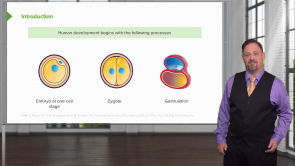Terminology & Concept Recap
About the Lecture
The lecture Terminology & Concept Recap by Georgina Cornwall, PhD is from the course Single-Gene Disorders.
Included Quiz Questions
What is a locus in genetics?
- A fixed position on a chromosome where a gene is located.
- A group of alleles of different genes on a single chromosome.
- The observable properties of an organism.
- The total genetic constitution of an individual.
- The corresponding alleles on two chromosomes.
What is a haplotype?
- A group of genes within an organism inherited from one parent.
- The location of a gene on a chromosome.
- The observable properties of an organism.
- The total genetic constitution of an individual.
- One of two or more versions of a known mutation.
What is a phenotype?
- The observable properties of an organism.
- An individual with two different mutant alleles.
- The location of a gene on a chromosome.
- The total genetic constitution of an individual.
- One of two or more versions of a known mutation.
What is a genotype?
- The total genetic constitution of an individual.
- The observable properties of an organism.
- An individual with two different mutant alleles instead of one wild-type and one mutant allele.
- A group of alleles of different genes on a single chromosome.
- The location of a gene on a chromosome.
What is a compound heterozygote?
- The presence of two different mutant alleles at a particular gene locus.
- The location of a gene on a chromosome.
- One of two or more versions of a known mutation.
- A group of alleles of different genes on a single chromosome.
- The total genetic constitution of an individual.
What is pleiotropy?
- A single gene mutation that affects multiple traits.
- The proportion of individuals that express the phenotype of a particular genotype.
- The degree to which a particular genotype affects the phenotype.
- Multiple gene mutations with a single effect.
- The proportion of individuals with a heterozygous genotype.
Which of the following best describes penetrance?
- The proportion of individuals that express the phenotype of a particular genotype.
- A single gene mutation with multiple effects.
- The degree to which a particular genotype affects the phenotype.
- Multiple gene mutations with a single effect.
- The proportion of individuals with a heterozygous genotype.
What is expressivity?
- The degree to which a particular genotype affects the phenotype.
- The proportion of individuals with heterozygous genotype.
- A single gene mutation with multiple effects.
- Multiple gene mutations with a single effect.
- The proportion of individuals that express the phenotype of a particular genotype.
Which of the following statements best exemplifies variable penetrance?
- 80% of individuals with a mutation in the BRCA1 gene develop breast cancer.
- 100% of individuals with the BRCA1 gene develop breast cancer.
- BRCA1 can lead to breast cancer, ovarian cancer, or both.
- No individual with a mutation in the BRCA1 gene would develop breast cancer.
- Mutation in the BRCA1 gene only leads to breast cancer.
Which of the following statements best exemplifies variable expressivity?
- Twin sisters with the same BRCA1 gene mutation may develop different cancers.
- Mutation in the BRCA1 gene only leads to breast cancer.
- 80% of individuals with a mutation in the BRCA1 gene develop breast cancer.
- All patients with BRCA1 will develop ovarian cancer.
- No individual with a mutation in the BRCA1 gene would develop breast cancer
These courses may be of interest to you
Customer reviews
5,0 of 5 stars
| 5 Stars |
|
5 |
| 4 Stars |
|
0 |
| 3 Stars |
|
0 |
| 2 Stars |
|
0 |
| 1 Star |
|
0 |









